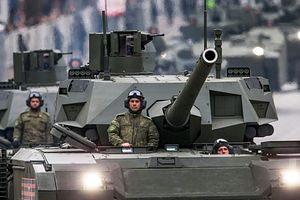Russia will begin state trials of its new third-generation T-14 “Armata” main battle tank (MBT) this year, the Russian Ministry of Defense (MoD) said in a December 30 statement. “The T-14 tank, which has been created on the universal Armata platform and developed for the Ground Forces, is completing the manufacturer’s trials. The fighting vehicle in 2019 will start undergoing state trials in the Russian Defense Ministry’s scientific and research institutions,” the statement reads.
The “Armata” universal chassis system also serves as a platform for over a dozen different tracked armored vehicles, including a self-propelled artillery howitzer and an armored military engineering vehicle. The MoD designates the T-14 as a third-generation tank MBT. It is one of the world’s first MBTs to feature an unnamed turret. The tank is also equipped with Malachit reactive armor modules and the advanced Afganit active protection system, although the latter’s precise operational capability remains unknown.
The tank’s main weapon system is the auto-loading A82 125-millimeter smoothbore cannon. The 125-millimeter variant may be replaced with a more powerful 152 mm cannon in later versions, although this would reduce the T-14s ammunition capacity and likely require a complete re-design of the platform. The main gun will also be capable of firing of anti-tank guided weapons. Additionally, the tank is equipped with a 12.7 mm anti-aircraft machine gun and a 7.62 mm coaxial machine gun.
The Russian Ground Forces (RGF) are currently operating around 16-20 T-14s prototypes for testing. The MoD signed a contract with Russia’s main tank manufacturer Uralvagonzavod (UVZ) for the production of 132 T-14 Armata MBTs and T-15 heavy infantry fighting vehicles (IFV) in February 2018. The RGF are slated to receive a total of 100 T-14 MBTs over the next three years. Despite previous plans by the MoD, UVZ will not mass produce the T-14. Rather, the Russian tank makers will retrofit and upgrade Soviet-era models, including the T-72 and T-90 MBTs. As I explained elsewhere:
It has been obvious for some time (…) that the [MoD] has abandoned plans to mass-produce 2,300 T-14s by 2025, as was originally outlined in the 2018-2027 State Armaments Program. For example, already in October 2017 the MoD announced that it will upgrade T-80 and T-90 series MBTs and revise plans to melt down 10,000 armored vehicles by 2020 and keep 6,000 in reserve.
Also in January 2017, the MoD announced that it will upgrade its T-72 MBT force. “The Russian Ministry of Defense’s decision to upgrade older T-72 and T-90 models could be interpreted as a sign that despite earlier announcements, the T-14 will not replace the Soviet-era tanks as the mainstay of Russia’s tank force in the near future and that the Russian Ground Forces will continue to operate various MBT variants at least for the next decade,” I speculated at the time.
The first T-14 MBTs will reportedly be operationally deployed with the 1st Guards Tank Regiment of 2nd Guards Tamanskaya Motor Rifle Division, garrisoned in Moscow and part of Russia’s Western Military District.

































